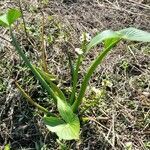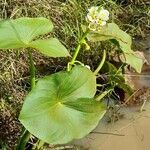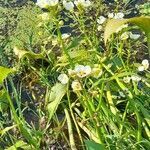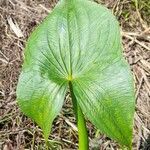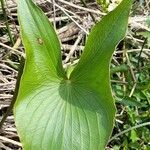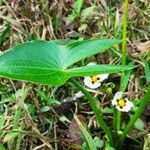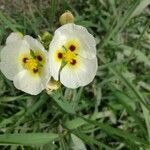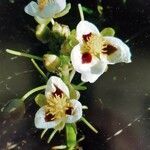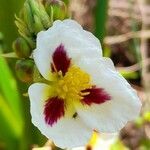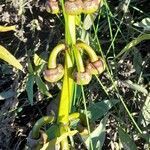Annual or perennial aquatic herb.. Leaves erect, floating or submerged; blade of erect leaves linear to broadly ovate, 0.5–25 × 2–20 cm., sagittate, with the lobes up to 20 cm. long, rarely reduced or absent; blade of floating leaves ovate, up to 1.5 × 2.5 cm.; submerged leaves reduced to phyllodes, up to 45 cm. long.. Peduncle erect, 7–75 cm. high, with 2–12 whorls of flowers, the lowest sometimes of branches; bracts connate at their bases, up to 2.5 cm. long, membranous or sometimes thickened; pedicels of ♂ flowers 1–4 cm. long; pedicels of ♀ flowers thickened, recurved, 1–7 cm. long.. Sepals ovate, 0.6–1.5 × 0 .6–1.5 cm., appressed in the female flowers.. Petals larger, up to 2.2 cm. long, white, sometimes with a purple mark at the base.. Stamens of ♂ flowers 12–∞; filaments linear or flattened, glabrous or pubescent, 0 .7–3.5 mm. long; anthers oblong, 0.4–1.3 mm. long; ♀ flowers occasionally with a ring of 9–12 functional stamens.. Abortive carpels in ♂ flowers about as many as stamens, 1.5 × 0.5 mm.; carpels in ♀ flowers ∞, 2 × 1 mm.. Fruiting head up to 2.5 cm. in diameter; achenes up to 1.5 × 3 mm. with a beak up to 1 mm. long.
Herbs, annual or perennial, to 100 cm; rhizomes present; stolons present; corms present. Leaves submersed and emersed; submersed leaves absent or phyllodial, flattened, to 17 ´ 2 cm; emersed leaves with petiole triangular, 21--55 cm, blade hastate to sagittate, 2.5--17.5 ´ 0.6--22 cm, lobes longer than or equal to remainder of blade. Inflorescences racemes or panicles, of 1--15 whorls, floating or emersed, 1.5--28 ´ 1.5--15 cm; peduncles 15--47 cm; bracts distinct or connate less than ¼ total length, lanceolate to elliptic, 4--34 mm, delicate, not papillose; fruiting pedicels recurved, club-shaped, 0.5--4.2 cm. Flowers 2--5 cm diam.; sepals spreading in staminate, erect in pistillate, enclosing flower or fruiting head; filaments cylindric, longer than anthers, glabrous; pistillate pedicellate, with or without ring of sterile stamens. Fruiting heads 1.2--2.1 cm diam.; achenes oblanceoloid, not abaxially keeled, 2--4.3 ´ 0.7--1.5 mm, beaked; faces not tuberculate, wings absent, glands 1; beak lateral, horizontal, 0.4--0.8 mm.
A herb. It has rhizomes. It grows 80-150 cm tall. The leaves are sword shaped and 25-30 cm long by 20 cm wide.
